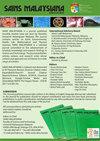Rare Earth Element Characterization of Bledug Kuwu Mud Volcano, Central Java, Indonesia, based on Geochemical Analyzes (Susceptibility, XRF, XRD, SEM-EDS and ICP-EOS)
IF 0.8
4区 综合性期刊
Q3 MULTIDISCIPLINARY SCIENCES
引用次数: 0
Abstract
Mud volcano material is generally rich in oxides, while oxides are the main compounds forming rare earth elements. Bledug Kuwu, Central Java, Indonesia, is one of the active mud volcanoes, so there may be rare earth elements. This research is the characterization of rare earth elements (REE) in the Bledug Kuwu mud using magnetic and geochemical methods. Magnetic characterization uses magnetic susceptibility measurements. The geochemical characterization of the mud samples consisted of the XRF (X-Ray Fluorescence), XRD (X-Ray Diffraction), ICP-EOS (inductively coupled plasma) test, and the SEM-EDS (Scanning Electron Microscopy-Energy Dispersive X-Ray Spectroscopy) test. The results of the geochemical analysis of the Bledug Kuwu mud sample were the content of quartz, kaolinite, and calcite with an average concentration of 42.26%, 23.67%, and 33.96%. The susceptibility of Kuwu's mud is 0 because the concentration of metal elements is low; according to the results of XRF, XRD, and SEM tests identified the main mud elements as C, O, Si, Ca, and Al. The rare earth elements in Kuwu's mud are Ce, Dy, Eu, Gd, Ho, La, Nd, Pr, Sm, Tb, Y, and Sc. The highest concentrations were Ce 52.22 ppm and La 47.95 ppm.基于地球化学分析(感应性、XRF、XRD、SEM-EDS 和 ICP-EOS)的印度尼西亚中爪哇 Bledug Kuwu 泥火山稀土元素特征分析
泥火山物质一般富含氧化物,而氧化物是形成稀土元素的主要化合物。印度尼西亚中爪哇的 Bledug Kuwu 是活泥火山之一,因此可能存在稀土元素。本研究使用磁性和地球化学方法对 Bledug Kuwu 泥浆中的稀土元素(REE)进行表征。磁性表征使用磁感应强度测量。淤泥样本的地球化学表征包括 XRF(X 射线荧光)、XRD(X 射线衍射)、ICP-EOS(电感耦合等离子体)测试和 SEM-EDS(扫描电子显微镜-能量色散 X 射线光谱)测试。Bledug Kuwu 淤泥样本的地球化学分析结果显示,石英、高岭石和方解石的平均含量分别为 42.26%、23.67% 和 33.96%。根据 XRF、XRD 和 SEM 测试结果,确定库乌淤泥的主要元素为 C、O、Si、Ca 和 Al。Kuwu 泥中的稀土元素有 Ce、Dy、Eu、Gd、Ho、La、Nd、Pr、Sm、Tb、Y 和 Sc。最高浓度为 Ce 52.22 ppm 和 La 47.95 ppm。
本文章由计算机程序翻译,如有差异,请以英文原文为准。
求助全文
约1分钟内获得全文
求助全文
来源期刊

Sains Malaysiana
MULTIDISCIPLINARY SCIENCES-
CiteScore
1.60
自引率
12.50%
发文量
196
审稿时长
3-6 weeks
期刊介绍:
Sains Malaysiana is a refereed journal committed to the advancement of scholarly knowledge and research findings of the several branches of science and technology. It contains articles on Earth Sciences, Health Sciences, Life Sciences, Mathematical Sciences and Physical Sciences. The journal publishes articles, reviews, and research notes whose content and approach are of interest to a wide range of scholars. Sains Malaysiana is published by the UKM Press an its autonomous Editorial Board are drawn from the Faculty of Science and Technology, Universiti Kebangsaan Malaysia. In addition, distinguished scholars from local and foreign universities are appointed to serve as advisory board members and referees.
 求助内容:
求助内容: 应助结果提醒方式:
应助结果提醒方式:


